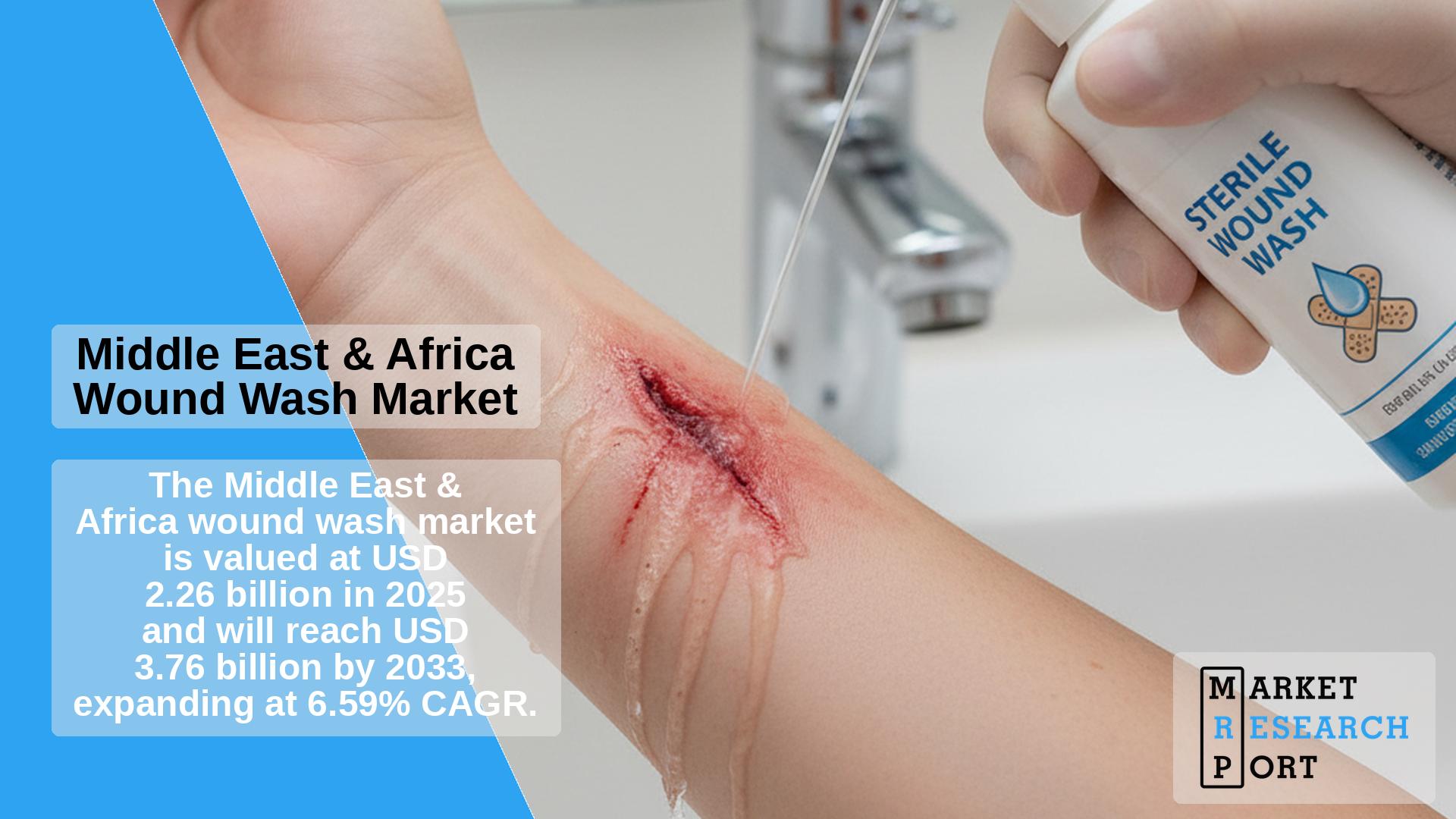
The Middle East & Africa (MEA) wound wash market was valued at approximately USD 2.26 billion in 2025, expected to reach USD 3.76 billion by 2033, growing at a compound annual growth rate (CAGR) of 6.59% from 2025 to 2033. Market expansion is attributed to increasing prevalence of chronic and acute wounds like diabetic ulcers and surgical injuries, alongside improved healthcare infrastructure and accessibility across the region.
Technological advancements in bioactive and antimicrobial wound cleansers, shifting focus toward home healthcare and self-care, and government initiatives to improve chronic wound management drive market growth. The rise in road traffic injuries, particularly in countries such as UAE, Qatar, and Egypt, escalates demand for effective wound wash products to clean and prevent infections in trauma wounds.
The aging population in the region is another significant factor. Older adults are more prone to both acute and chronic wounds due to surgeries and prevalent chronic illnesses like diabetes and hypertension, which increase complications like diabetic foot ulcers and pressure ulcers.
Aging populations across MEA countries are rising, with significant numbers aged 65 and above:
| Country | 2021 | 2022 | 2023 | 2024 |
|---|---|---|---|---|
| UAE | 155,044 | 165,203 | 177,766 | 192,192 |
| Saudi Arabia | 806,106 | 869,534 | 950,250 | 1,041,656 |
| Egypt | 5,260,374 | 5,437,664 | 5,692,068 | 5,962,442 |
| South Africa | 3,834,457 | 3,968,282 | 4,118,346 | 4,282,432 |
The MEA wound wash market is moderately innovative, supported by advanced wound care technologies and regional healthcare modernization efforts like Saudi Vision 2030 and UAE Centennial 2071. These initiatives encourage local production and adoption of bioactive and antimicrobial cleansers.
Regulatory adherence plays a key role, with countries aligning with global standards such as ISO and CE marking. Strict product registration, testing, and local content regulations shape market access and development.
M&A activity is moderate but growing, primarily involving acquisitions of regional distributors and partnerships with local companies, enabling global players to expand distribution and product portfolios.
Substitute products (e.g., soap, plain saline irrigation) exist but wound washes are preferred due to superior healing promotion and infection prevention.
Antiseptic wound wash products, including povidone-iodine, chlorhexidine, and hydrogen peroxide, dominated with a 47.58% share in 2024. Their broad antimicrobial activity, affordability, and easy availability position them as essential for acute and chronic wound management.
Saline solutions are forecasted for the highest growth due to their gentle, non-irritating properties and suitability for frequent wound irrigation without tissue damage, increasingly preferred in outpatient and home-care.
Solutions are the leading form due to versatility and ease of clinical and home use. Wipes, however, are gaining rapid popularity for their convenience, portability, and effective cleansing in diverse settings.
Acute wounds, such as surgical and traumatic wounds and burns, accounted for the largest market share. Increased awareness of infection prevention and advances in formulae and delivery formats aid accessibility and effectiveness.
Chronic wounds (diabetic foot ulcers, pressure ulcers, venous leg ulcers) are the fastest-growing application segment, driven by rising diabetes prevalence, aging demographics, and expanded specialized wound care centers.
Hospitals dominate usage given advanced infrastructure and specialist care. Military and defense sectors forecast fastest growth due to demand for rapid, portable wound care in conflict zones and training environments.
Saudi Arabia leads regional revenue due to strong government healthcare investments and chronic disease prevalence.
This report includes detailed analysis of growth drivers, competitive trends, and revenue forecasts from 2021 to 2033, segmented by product type, product form, application, end use, and region within the Middle East & Africa.
Which product segment leads the market?
The antiseptic segment held the largest revenue share of 47.58% in 2024.
Who are key market players?
The market includes prominent companies such as Atlantis Consumer Healthcare, Medline Industries, B. Braun SE, Mölnlycke Health Care, and Johnson & Johnson Consumer Inc.
What factors drive market growth?
Increasing chronic and acute wound incidence, expanding healthcare access, and government healthcare initiatives.
How large is the market?
The MEA wound wash market was valued at USD 2.12 billion in 2024 and is expected to grow to USD 2.26 billion in 2025.
What is the expected growth rate?
The market is projected to grow at a CAGR of 6.59% from 2025 to 2033.